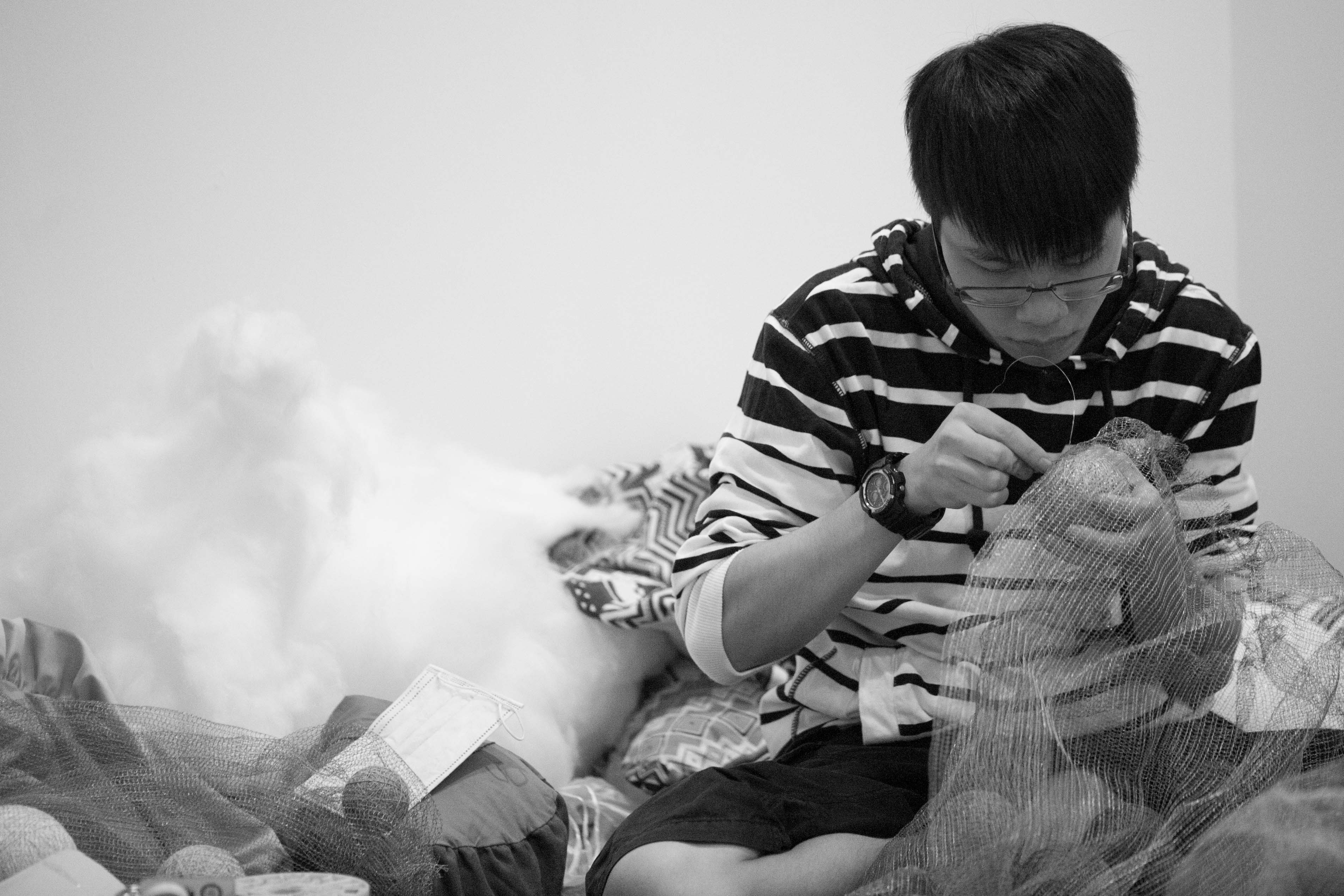An onion can produce five different dye colours, from brown to dark yellow. This is something I learnt from Ah Dou when we met at the village where he spent three years learning how to dye and weave.
It was October of last year. I travelled into the mountains two hours’ drive outside Taichung city centre. No taxi driver in the city has ever been to the place that I wanted to go. When I got there, I realised why no one knew the place. Apart from the Atayal, an indigenous tribe who have lived there for hundreds of years, there is nothing else, not even one single convenience store.
I went into the mountains to meet Linus Cheung Shing, or Ah Dou (Cantonese for Beanie), as he’s known to his friends. Ah Dou is 21, and I was surprised that this young friend of mine could spend three years at a place where no modern forms of entertainment exist.
Ah Dou promised to be my guide and to introduce me to the Atayal weaving tradition which he had been passionately learning for the previous three years. I made the trip because he’s about to graduate from his self-designed three-year weaving apprenticeship after which he’d be returning to Hong Kong.
Ah Dou didn’t go to university. He didn’t even do his HKCEE which is the most basic local secondary education qualification needed for university entry in Hong Kong. He had decided long ago that he would not go the conventional way.
“My interest is in crafts, various forms of craft and wood making in particular. Besides, I’m slow. When it comes to work, or getting things done, I have my own rhythm. Going to college and receiving a formal education is not for me,” Ah Dou said.
In the mountains, he didn’t only learn how to weave, he also learnt how to grow the particular plant that produces the fabric for the threads he uses for weaving. Learning how to dye was part of his education too, and I found out that the weavers coloured the threads instead of the cloths. At the workshop that his mentor Yama Taru runs, Ah Dou worked as the chef and the tutor. He’s also Yama’s assistant. He would cook for the whole team of about 12 people at the workshop, and he also gave lectures on weaving at community centres and schools. Ah Dou also played a role in curating exhibitions that the workshop was invited to stage. “Basically I did everything an apprentice has to do.”
In the Atayal tribe, weaving and all other related skills are reserved for women, whereas tradition governs that men in the tribe have to work as hunters. However, Yama broke the rule by letting Ah Dou learn the traditional weaving skills which she had acquired from her grandmother and other elderly women. But one important requirement she set Ah Dou is that he should stick to the modern weaving machine and not to use the traditional craft. She worries any contact with the traditional instrument would bring bad luck to the young man.
Before leaving Hong Kong in 2009, Ah Dou took some creative arts courses at one of the city’s few high schools that offer such courses. He also worked as a part-time librarian there to earn some money. During this time, he also travelled to the US and Taiwan. In the US, he attended one short course on meditation and another one to learn how to build tree houses. In Taiwan, he visited farms and handicraft workshops, researching and thinking about what he should learn. Though he subsequently decided that he wanted to learn weaving, his big goal in the long run is to be a tree house architect. “It has been my dream since I was six. As I grew up, I developed a better idea about this childhood dream. I want to use natural, indigenous materials to build houses on trees, such as straws from the fields. I don’t know how I’m going to get it done but I know I will get it done eventually. My dream is to have a field that allows me to live in a tree house and farm. However that may not be in Hong Kong because the city’s land is so expensive. And even if I can buy a piece of land, the government can probably resume it for development anytime it likes.”
Over the past three years, Ah Dou would come back to Hong Kong at year-ends and in the summertime for temporary jobs that would allow him to make enough cash to support himself while he’s pursuing his dreams in Taiwan. The path that Ah Dou has carved out for himself is clearly unorthodox and far from economically secure by Hong Kong standards. Yet he is not particularly worried about how much money his choices can earn him. “I’m pursuing a lifestyle, a way of living, I’m not looking for a job. I visited a number of farms in Taiwan, during which I also learned farming. As long as I have a plot of land, I can grow my own food. Surviving is not hard, so I’m not particularly worried about how much money I can make.”
During my brief stay in the mountains, I weaved under Ah Dou’s guidance. He and his colleagues, who are members of the Atayal tribe, also told me about the history and the culture of the tribe and how they were prosecuted during the Japanese colonial period in Taiwan a century ago.
I learnt from them that the Atayal tribe didn’t used to have any written language, and they passed down their traditions from generation to generation through patterns sewn on their fabrics. For centuries, girls in the tribe learnt how to weave so they could make their own wedding gowns. After they got married, they’d make clothes for the whole family. During the Japanese colonial period in Taiwan, the tribe was forbidden from weaving and they had to use fabrics imported from Japan. As a result, they lost their weaving skills and subsequently their traditions.
Ah Dou’s colleagues also told me that, in the past, women in the Atayal tribe had to be masters of weaving in order to earn the right to get a facial tattoo, or they would not be entitled to get married.
On top of helping to run Yama’s workshop and teaching me the basics of weaving, during my visit Ah Dou was also busy making a wool/linen fabric in partnership with a Swedish designer. “This fabric is a furniture cover. The Swedish company is fascinated by our skills, so they’re working with us. The pattern and the colours are from them. Their design is better than what we have in Taiwan.”
Before I met Ah Dou at the workshop, I knew he had been planning to go to Europe. He had felt strongly that he had to visit the continent to acquire more skills and his partnership with the Swedish designer was probably taking him in that direction.
Therefore, when we met for dinner later back in Hong Kong, my first question to him was when he’d be leaving for Europe.
“I need to figure out how the visas work first. I’ll go to Scotland for sure. I want to see how they make the Highland wear, the tartan patterns. I’ll also go to Switzerland for the quality wood making. The rest, I’m not sure. I’ll see.”
Now Ah Dou wants to make some money before he can embark on his next study trip. He is thinking whether he should teach weaving. The secondary school where he used to study has asked him to teach weaving classes. However, he isn’t sure if he’s ready yet. “The biggest problem is I’m so young. Look at my face, how can I convince people that I can teach them?”
Q: What do you like the most about Hong Kong?
A: We have mountains and the countryside. I like the fact that they are accessible. Whichever part of Hong Kong we’re in, we’re never more than an hour away from a country hike.
Q: What do you dislike the most about Hong Kong?
A: It’s too crowded with people and there are too many tourists.
Q: Q: What does Hong Kong have to do to be sustainable?
A: Everyone should stay true to our heart.





